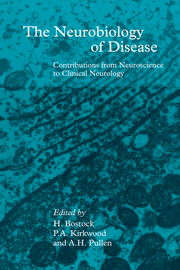Book contents
- Frontmatter
- Contents
- List of contributors
- Preface
- Part I Physiology and pathophysiology of nerve fibres
- 1 Ion channels in normal and pathophysiological mammalian peripheral myelinated nerve
- 2 Molecular anatomy of the node of Ranvier: newer concepts
- 3 Delayed rectifier type potassium currents in rabbit and rat axons and rabbit Schwann cells
- 4 Axonal signals for potassium channel expression in Schwann cells
- 5 Ion channels in human axons
- 6 An in vitro model of diabetic neuropathy: electrophysiological studies
- 7 Autoimmunity at the neuromuscular junction
- 8 Immunopathology and pathophysiology of experimental autoimmune encephalomyelitis
- 9 Pathophysiology of human demyelinating neuropathies
- 10 Conduction properties of central demyelinated axons: the generation of symptoms in demyelinating disease
- 11 Mechanisms of relapse and remission in multiple sclerosis
- 12 Glial transplantation in the treatment of myelin loss or deficiency
- Part II Pain
- Part III Control of central nervous system output
- Part IV Development, survival, regeneration and death
- Index
12 - Glial transplantation in the treatment of myelin loss or deficiency
from Part I - Physiology and pathophysiology of nerve fibres
Published online by Cambridge University Press: 04 August 2010
- Frontmatter
- Contents
- List of contributors
- Preface
- Part I Physiology and pathophysiology of nerve fibres
- 1 Ion channels in normal and pathophysiological mammalian peripheral myelinated nerve
- 2 Molecular anatomy of the node of Ranvier: newer concepts
- 3 Delayed rectifier type potassium currents in rabbit and rat axons and rabbit Schwann cells
- 4 Axonal signals for potassium channel expression in Schwann cells
- 5 Ion channels in human axons
- 6 An in vitro model of diabetic neuropathy: electrophysiological studies
- 7 Autoimmunity at the neuromuscular junction
- 8 Immunopathology and pathophysiology of experimental autoimmune encephalomyelitis
- 9 Pathophysiology of human demyelinating neuropathies
- 10 Conduction properties of central demyelinated axons: the generation of symptoms in demyelinating disease
- 11 Mechanisms of relapse and remission in multiple sclerosis
- 12 Glial transplantation in the treatment of myelin loss or deficiency
- Part II Pain
- Part III Control of central nervous system output
- Part IV Development, survival, regeneration and death
- Index
Summary
The purpose of this chapter is to consider what, realistically, might be achieved by glial transplantation, to review what has been done thus far in the field, and to present several current unresolved issues and controversies that are the subjects of continuing investigation.
What are the aims of glial transplantation?
When myelin in the central nervous system (CNS) has been lost as a result of disease or trauma, endogenous glial cells may not remyelinate. In those cases in which demyelination persists, glial transplantation offers the potential of repairing lesions that would otherwise remain and, perhaps, of alleviating functional deficits associated with the demyelination. These deficits fall into two categories: conduction block and spontaneous activity.
Conduction block
Although it is often assumed that demyelination inevitably results in conduction block, it has been known for more than 15 years that some fibres exhibiting experimental segmental demyelination are, in fact, able to conduct (Bostock & Sears, 1978). Signals are carried by saltatory conduction along the myelinated portion of the axon, then by continuous conduction along the demyelinated segment, then by saltatory conduction again beyond the site of demyelination. All that appears to be lost is the additional time required for continuous conduction (Fig. 12.1).
Even though frank conduction block does not occur in such fibres there are, nevertheless, other potential functional deficits. The demyelinated segment may not be able to conduct trains of impulses at high frequency, and it may fatigue quickly, since continuous conduction is metabolically more expensive than saltatory conduction (see below).
- Type
- Chapter
- Information
- The Neurobiology of DiseaseContributions from Neuroscience to Clinical Neurology, pp. 124 - 148Publisher: Cambridge University PressPrint publication year: 1996
- 6
- Cited by

